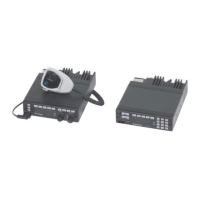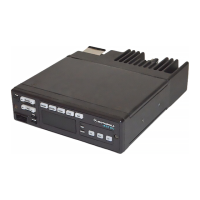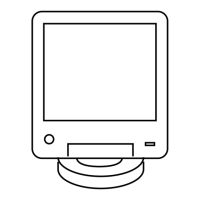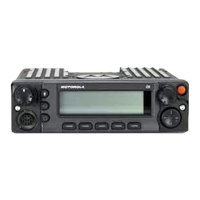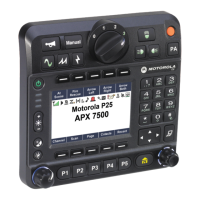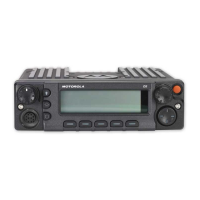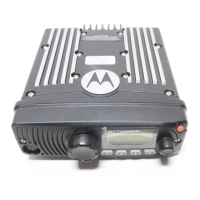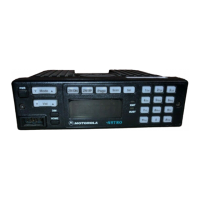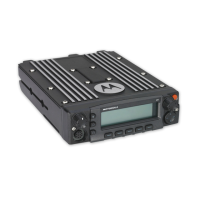February 3, 2003 6881076C20-E
3-6 Basic Theory of Operation: Voltage-Controlled Oscillator (VCO)
Synthesizing for the first and second VCO is performed by the prescaler and synthesizer ICs. These
ICs are programmed through a serial data bus from signals generated on the VOCON board. A dc
voltage, generated on the command board, sets the synthesizer’s reference oscillator frequency of
16.8MHz. This voltage is controlled by the digital-to-analog converter (D/A), and is the only element
of the RF board requiring alignment.
The second local oscillator runs at 109.2MHz (low-side injection), and consists of a VCO that is
frequency-locked to the reference oscillator. Part of the local oscillator’s circuitry is in the prescaler
IC.
A clamp and rectifier circuit on the RF board generates a negative dc voltage of 4 volts (nominal) for
increasing the total voltage available to the first VCO and second local oscillator’s VCO. The circuit
receives a 300 kHz square wave output from the prescaler IC, then clamps, rectifies, and filters the
signal for use as the negative steering line for the two VCOs.
3.9 Voltage-Controlled Oscillator (VCO)
3.9.1 VHF Radios
The voltage-controlled oscillator (VCO) assembly utilizes a common-gate FET in a Colpitts
configuration as the gain device. The LC tank circuit’s capacitive portion consists of a varactor bank
and a laser-trimmed stub capacitor. The inductive portion consists of microstrip transmission line
resonators. The stub capacitor serves to tune out build variations. Tuning is performed at the factory
and is not field adjustable. The varactor network changes the oscillator frequency when the dc
voltage of the steering line changes. The microstrip transmission lines are shifted in and out of the
tank by PIN diodes for coarse frequency jumps. A third varactor is used in a modulation circuit to
modulate the oscillator during transmit.
The VCO output is coupled to a transistor for amplification and for impedance buffering. The output
of this stage passes through a low-pass filter where the signal is split into three paths. One path
feeds back to the synthesizer prescaler; the other two provide injection for the RX and TX
amplification strings. The receive injection signal is further amplified and passed to the RX front-end
injection filter. The transmit signal goes to an ECL divider, which divides the signal by two. The signal
is amplified and buffered and then injected into the transmitter’s low-level amplifier.
A 5V regulator provides power to the divider. All transmit circuitry operates from keyed 9.4 volts to
conserve current drain while the radio is receiving. A transistor/resistor network drives the PIN
diodes in the VCO tank. These driver networks provide forward bias current to turn diodes on and
reverse the bias voltage to turn the diodes off. AUX 1 AND AUX 2 lines control the PIN diode driver
networks.
3.9.2 UHF and 800 MHz Radios
The VCO assembly generates variable frequency output signals controlled by the two steering lines.
The negative steering line increases the tuning range of the VCO, while the positive steering line
affects the synthesizer control loop to incrementally change the frequency.
The VCO generates a signal in the required frequency range. For UHF and 800 MHz radios, this
signal is fed to the doubler/buffer circuit which, in turn, doubles the VCO output frequency and
amplifies it to the power level required by the TX buffer and RX mixer. A PIN diode switch routes the
signal to the TX port when the keyed 9.4V is high. Otherwise, the signal is routed to the RX port. The
VCO assembly’s synthesizer feedback output is the same as the doubler output frequency.
3.10 Command Board
The serial input/output IC provides command board functions including buffers for PTT, channel
active, squelch mute, busy, and data transmission, and logic functions for switched B+, emergency,
reset, and power control.
